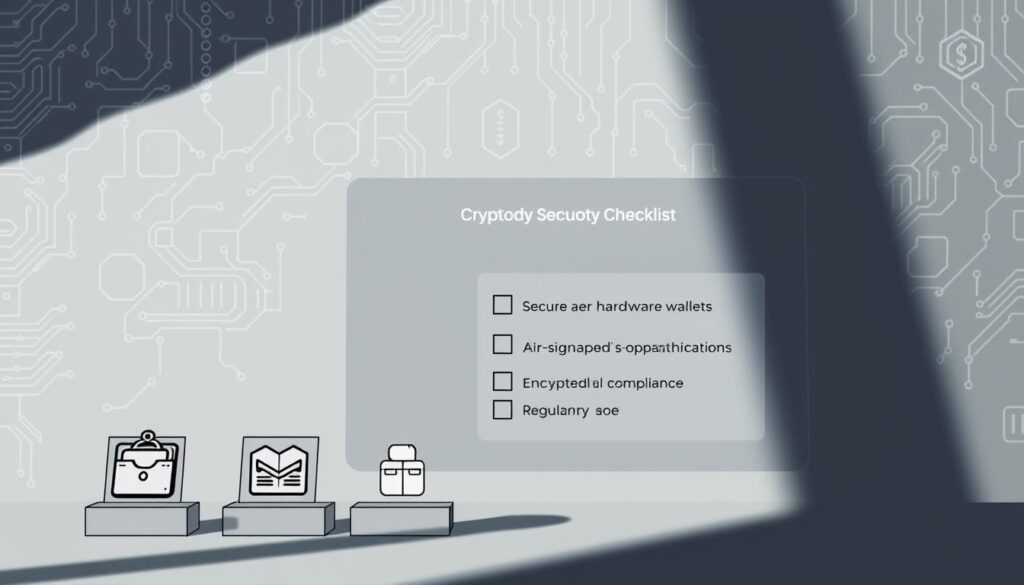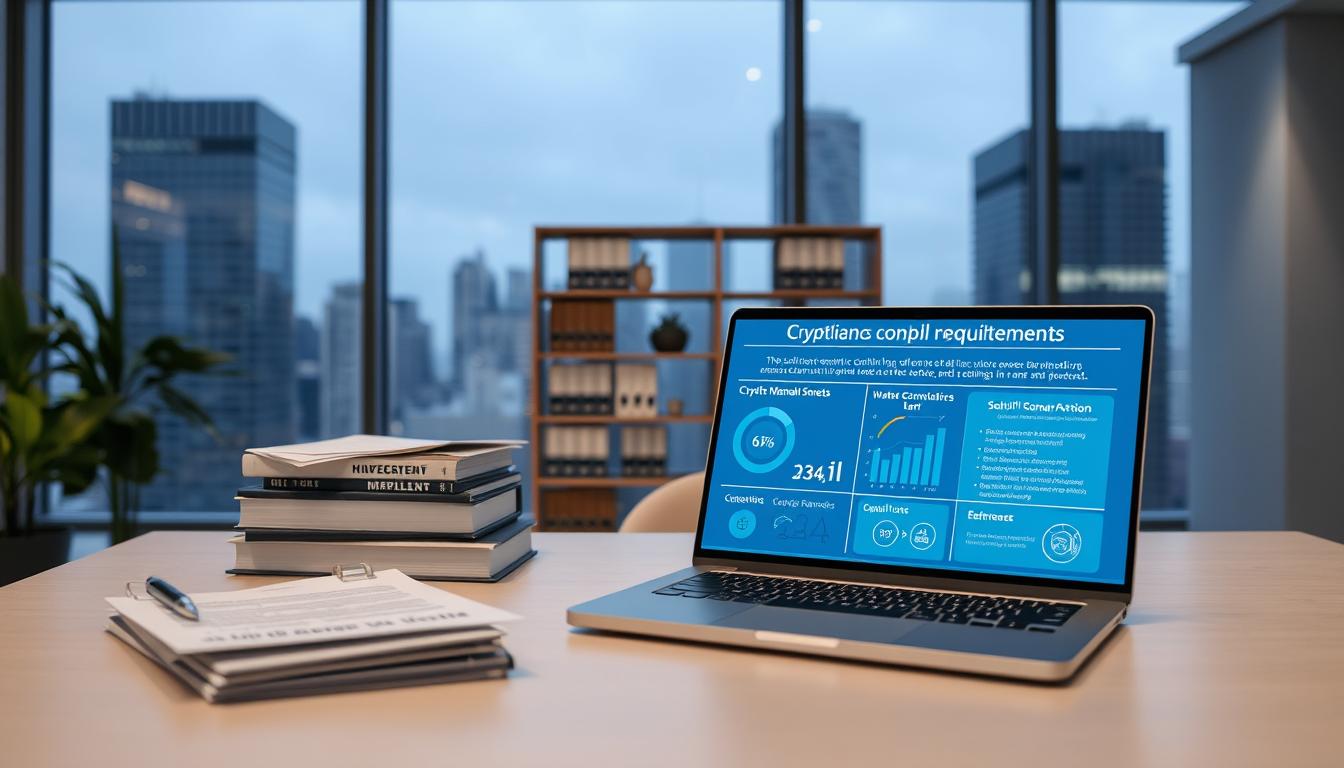Now Reading: Trusted Institutional Cryptocurrency Custody Solutions Providers
- 01
Trusted Institutional Cryptocurrency Custody Solutions Providers
Trusted Institutional Cryptocurrency Custody Solutions Providers

Digital asset safekeeping underpins how institutions and investors separate trading activity from the storage of private keys. The crypto market has shown extreme risks — lost keys and platform failures have cost billions and exposed counterparty gaps.
The buyer’s guide that follows will help organizations evaluate providers and services that reduce counterparty risk while meeting audit and regulatory duties. Expect discussion of cold storage, HSM-backed key management, multi-signature controls, multi-factor authentication, and multi-site redundancy as baseline security.
Qualified custodians and institutional crypto custody programs aim to prevent asset loss scenarios like high-profile collapses by enforcing segregation, clear insurance terms, and evidence-based controls. We also preview operational features institutions value: off-exchange settlement, OTC trading, staking from regulated storage, integrated APIs, and audit-ready reporting.
Finally, the guide covers evolving U.S. oversight, global frameworks such as MiCA and UAE rules, and the audit and compliance items to check when scoring providers.
Why Institutional Crypto Custody Matters Now in the United States
High-profile exchange failures have forced firms to rethink how they hold crypto and who they trust with client assets.

Market shocks exposed operational gaps. After events like FTX and reports of billions missing, counterparty risk moved to the top of the agenda for investors and institutions.
Market risks and counterparty exposure
Platforms can commingle funds or rehypothecate holdings. That creates chains of exposure that amplify loss when a firm fails.
No FDIC/SIPC safety net and fiduciary duties
Crypto and digital assets lack FDIC or SIPC backstops. Losses from misplaced private keys or platform collapses can be final.
- Segregated client accounts reduce exposure to platform failures.
- Robust controls — cold storage, multi-signature, insured arrangements — support fiduciary obligations.
- Trading and settlement needs require custody services designed for large orders and tight reconciliation.
| Risk | Impact | Control |
|---|---|---|
| Commingling / Rehypothecation | Loss spreads across creditors | Segregation & audited reporting |
| Private key loss | Irrecoverable asset loss | Cold storage & key governance |
| Market volatility | Liquidity squeezes, forced sales | Settlement windows & liquidity planning |
Regulatory momentum in the U.S. means buyers should favor providers built for scrutiny. For more on how investors evaluate these arrangements, see crypto institutional investment.
What Institutional Digital Asset Custody Is and How It Works
Top-tier storage frameworks pair networked wallets for market activity with hardened offline vaults for asset preservation.
Digital asset custody means a third party safeguards private keys and controls transaction authorization workflows for compliance, operations, and trading teams.
Hot wallets stay online to support fast settlement and trading. They give quick access but raise the attack surface and require tight monitoring.
Cold storage keeps key material offline in vaulted, air-gapped environments. HSM-backed key management enforces FIPS-grade protections; keys cannot be extracted and signing needs quorum approvals.

Custodians operate with onboarding, address whitelisting, policy engines, role-based approvals, and API integration so trading and compliance teams use services within set policies.
Trade-offs: hot tiers meet liquidity needs, while cold tiers reduce theft risk and support insurance terms. Good providers document SOC reports, incident response plans, and multi-site recovery to prove controls beyond marketing claims.
Institutional Cryptocurrency Custody Solutions: The Security Checklist
A clear security checklist helps firms separate marketing claims from proven controls when evaluating crypto custody providers.

Cold storage as default: Hold most long-term crypto in offline vaults. Use air-gapped key ceremonies and documented procedures to reduce network exposure for private keys.
HSM and FIPS controls: Require FIPS-rated HSMs that keep keys non-extractable, produce tamper-evident logs, and support approved RNG methods for key generation.
Multi-signature & quorum: Enforce policies that split signing across separate teams. Quorum protocols prevent a single user from moving asset holdings.
MFA beyond SMS: Use authenticator apps, hardware tokens, and conditional access tied to transaction thresholds and whitelists.
Geographic redundancy: Replicate key shares across sites so no single site can approve withdrawals. Multi-site storage protects access during outages.
Operational governance: Role separation, mandatory rotations, four-eyes checks, and automatic officer reviews for large transfers support auditors’ expectations.
- Audit evidence: Demand immutable trails, on-chain proofs, and SOC 1/2 Type II reports.
- Insurance scope: Verify coverage details, limits, and covered events when providers control all keys.
| Feature | Why it matters | What to verify | Expected control |
|---|---|---|---|
| Cold storage | Reduces online attack surface | Air-gapped ceremonies, vault SOPs | Most long-term assets offline |
| HSM / FIPS | Protects key material on-device | FIPS level, tamper logs, RNG | Non-extractable keys, audit logs |
| Multi-sig & MFA | Prevents single-point failure | Quorum rules, authenticator/hardware tokens | Policy-based multi-approver flows |
| Geo redundancy & governance | Resilience and auditability | Site separation, role separation, SOC reports | Replicated sites, officer reviews |
Beyond Security: Custody Services and Trading Capabilities Institutions Need
Institutions need more than vaults; they need trading-grade services that preserve capital and reduce market impact. Good offerings combine safe storage with execution, staking, and reconciliation so portfolio teams can act without adding operational risk.

Off-exchange settlement and OTC execution
Off-exchange settlement reduces exposure to exchange failures and front-running for block-size orders. It also lowers visible order flow that would move the market.
OTC execution brings price discovery and discrete liquidity sourcing. When tightly integrated with custody services, OTC trades settle faster and avoid manual post-trade steps.
Staking from regulated cold storage
Staking programs run from regulated cold storage can generate yield—often north of 3%—while keeping key material offline. Providers should document validator governance, slashing monitoring, and clear reward accounting for tax and audit teams.
APIs, asset coverage, and audit-ready reporting
Integrated trading APIs connect custody to brokers, exchanges, and OMS/EMS systems. That enables automated policy checks, address whitelisting, and pre-/post-trade controls.
Broad asset coverage—stablecoins and major proof-of-stake networks—supports diversified portfolio use while staying inside compliance boundaries.
Audit-ready reports mean real-time reconciliation between on-chain balances and books, exportable evidence for auditors, and role-based dashboards for compliance and operations teams.
- Test authentication and approval flows in staging to validate roles and transaction limits before production.
- Require published SLAs for settlement times, API uptime, and incident response so investors can benchmark performance.
| Metric | Expectation | Why it matters |
|---|---|---|
| Settlement SLA | Defined hours / minutes | Plans liquidity and limits counterparty exposure |
| API uptime | 99.9%+ | Keeps trading and reconciliation automated |
| Incident response | Documented RTO / RPO | Supports continuity and audit reviews |
For a deeper look at service offerings that pair secure storage with trading workflows, see custody services for asset managers.
Regulation, Assurance, and Transparency for Institutional Crypto Custody
Regulatory clarity is reshaping how firms select and monitor digital asset guardians.
U.S. direction and qualified custodian expectations
The United States is shifting from enforcement to clearer rules from the SEC. Expect emphasis on client asset segregation, hardened cybersecurity, and documented officer reviews.
Providers should show cold storage, multi-signature controls, strong authentication, and written policy enforcement to meet evolving standards.
SOC reports and independent assurance
SOC 1 Type II and SOC 2 Type II attestations provide time-bound evidence that control objectives operate effectively.
Auditors and regulators rely on these reports to verify financial controls, data integrity, and security practices rather than accepting marketing claims.
KYC/AML, insurance, and fund segregation
KYC/AML screening, sanctions checks, and transaction monitoring are required to align operations with U.S. and global regulations.
Insurance often focuses on theft and criminal acts, but coverage varies. Review limits, exclusions, and activation conditions—especially if the custodian controls private keys.
Transparency items to require:
- Incident response plans, disaster recovery tests, and pen-test schedules.
- Evidence of legal entity separation and segregated client accounts when trading affiliates exist.
- Periodic service reviews to test access, emergency procedures, and change management.
| Area | Expectation | Why it matters |
|---|---|---|
| Segregation | Separate client accounts and legal ring-fencing | Protects client funds during provider insolvency |
| SOC attestations | SOC 1/2 Type II reports | Independent proof of controls over time |
| Insurance | Theft, operational error, key compromise (varies) | Mitigates loss but requires careful scope review |
| KYC/AML | Sanctions screening & transaction monitoring | Meets legal obligations and reduces market risk |
How to Choose a Custody Provider: A Buyer’s Framework
Selecting a custodian starts with a clear risk map and a repeatable due diligence workflow. Focus on evidence: controls, service levels, and legal separation rather than product marketing.
Risk management essentials
Insurance and scope: Request certificates and read exclusions. Match limits to your investment sizes and trading patterns.
Rehypothecation policies: Require written lending terms and explicit client opt-in. Avoid opaque chains that magnify risks to assets.
Client segregation: Confirm legal ring-fencing and proof of segregated accounts if the provider runs affiliated platforms.
Due diligence checklist
- Request SOC 1/2 reports, insurance binders, and written rehypothecation policies.
- Review security architecture: cold storage defaults, FIPS-rated HSMs, multi-signature controls, and MFA beyond SMS.
- Validate governance: role separation, quorum thresholds, officer approvals, and audit logs.
- Test continuity: multi-site setups, RTO/RPO targets, failover test outcomes, and reconciliation processes.
- Confirm service-levels: settlement times, API uptime, withdrawal SLAs, and documented incident history.
| Area | What to verify | Why it matters |
|---|---|---|
| Security architecture | HSMs, cold vault SOPs, multi-sig | Reduces theft and key compromise risk |
| Legal & insurance | Segregation proof, policy limits, exclusions | Limits loss and clarifies recovery paths |
| Operations | Reconciliation, SLAs, incident runbooks | Supports audit readiness and uptime |
Advice: score providers by assets supported, policy flexibility, and audit-ready reporting to ensure fit for institutional investors managing complex trading and compliance needs.
Conclusion
Good governance and tested workflows make the difference between recoverable incidents and permanent loss of private keys. Focus on providers that combine offline cold storage, HSM-backed key management, multi-signature approvals, MFA beyond 2FA, and multi-site redundancy to keep assets safe and access controlled.
Demand transparent information: SOC 1/2 reports, clear insurance terms, segregation evidence, KYC/AML attestations, and published incident postmortems. Those items prove controls beyond marketing claims.
Balance liquidity and safety by mapping hot wallet limits to trading needs while keeping most digital assets offline. Value-added services such as OTC execution, off-exchange settlement, staking, and API integration reduce friction and support growth.
Next step: apply the buyer’s framework, run technical workshops with finalists, and pilot to validate approvals, reporting, and operational readiness before full deployment.
FAQ
What are trusted institutional cryptocurrency custody providers?
Trusted providers are firms that offer secure storage, access controls, and regulatory-compliant services for digital assets. They combine cold storage, hardware security modules (HSMs), multi-signature approvals, and audited procedures to protect private keys and reduce counterparty risk for investors and financial institutions.
Why does crypto custody matter now in the United States?
Market volatility, recent exchange collapses, and limited FDIC/SIPC protection have highlighted counterparty exposure and operational gaps. Proper custody reduces the risk of loss, supports fiduciary duties, and helps institutions meet increasing regulatory scrutiny from the SEC and state regulators.
How do hot wallets and cold storage differ?
Hot wallets are online, offering fast access and liquidity for trading. Cold storage keeps private keys offline—usually in air-gapped devices or vaults—prioritizing security over speed. Institutions often use both: cold for long-term holdings and hot for operational needs.
Why is cold storage considered the default for long-term holdings?
Cold storage minimizes attack surfaces by keeping keys offline, using vaulting procedures, geographic redundancy, and strict access controls. These measures reduce the chance of remote compromise and help preserve assets across disasters or breaches.
What role do Hardware Security Modules (HSMs) play?
HSMs store and process private keys in tamper-resistant hardware, often meeting FIPS standards. They provide cryptographic operations without exposing raw keys, which strengthens key protection and supports auditability for institutional use.
How do multi-signature and quorum controls enhance security?
Multi-signature setups require multiple authorized signatures to move funds, spreading control across people or systems. Quorum-based controls limit single points of failure, enforce separation of duties, and reduce insider threat risk.
What forms of multi-factor authentication (MFA) should institutions require?
Beyond basic two-factor methods, institutions should use hardware tokens, biometric verification, and policy-driven access controls. Strong MFA reduces the chance of unauthorized access from phishing, credential theft, or social engineering.
How important is geographic redundancy and multi-site storage?
Geographic redundancy protects assets from regional outages, natural disasters, or targeted attacks. Multi-site storage and independent key shards ensure business continuity and faster recovery while maintaining secure key management.
What operational governance practices should custody providers have?
Providers should enforce role separation, strict change controls, clear incident response plans, and full audit trails. Regular internal and external audits, staff background checks, and documented procedures support reliable operations.
What trading and settlement services should an institutional custodian offer?
Look for off-exchange settlement and OTC execution to limit market impact, integrated trading APIs for automation, and broad asset coverage. These services should combine with secure custody to enable efficient portfolio management.
Can custodians support staking and yield while maintaining security?
Yes. Some custodians enable staking from regulated cold-storage environments with operational oversight, slashing protections, and clear governance. Proper design separates signer duties and ensures rewards flow into segregated client accounts.
What reporting features should be non-negotiable?
Audit-ready reporting, real-time reconciliation, and detailed transaction logs are essential. These features help with regulatory compliance, fund accounting, and internal controls for governance teams and auditors.
Which regulatory assurances matter most for custody providers in the U.S.?
Providers should pursue SOC 1/2 attestations, independent security audits, and clear alignment with SEC guidance on qualified custodians. Compliance with KYC/AML rules, appropriate insurance coverage, and client asset segregation are also critical.
How should institutions assess insurance and rehypothecation policies?
Verify insurance scope, exclusions, and claim processes. Confirm whether providers rehypothecate assets, and if so, under what terms. Prefer custodians that clearly segregate client holdings and limit rehypothecation to transparent, contractually defined scenarios.
What belongs on a due diligence checklist for choosing a custodian?
Key items include security architecture reviews (HSM, cold storage, MFA), data protection practices, service-level agreements, disaster recovery plans, incident history, independent audit reports, and regulatory standing. Vendor stability and customer references also matter.
How can institutions reduce counterparty and operational risk when using a custodian?
Use multiple custodians for diversification, require strict segregation of client assets, enforce contractual SLAs, and conduct continuous vendor monitoring. Regularly test recovery procedures and validate proof-of-controls through independent audits.
What are common red flags when evaluating custody providers?
Red flags include lack of independent audits, opaque insurance terms, single points of key control, missing disaster recovery plans, limited asset coverage, and unclear regulatory status. Avoid providers that cannot demonstrate strong operational and governance practices.














